ISSN ONLINE(2319-8753)PRINT(2347-6710)
ISSN ONLINE(2319-8753)PRINT(2347-6710)
Vladan Mićić1, Branko Pejović1, Milorad Tomić1 and Sabina Begić2
|
| Related article at Pubmed, Scholar Google |
Visit for more related articles at International Journal of Innovative Research in Science, Engineering and Technology
In this paper supercritical fluid extraction with carbon dioxide at different pressure was investigated and the total yield of the extract was measured. With increasing pressure from 80 to 300 bar extraction yield was increasing. It was due to the fact that supercritical carbon dioxide density increases by increasing pressures. Qualitative and quantitative analyses obtained extracts and essential oils obtained from these extracts were done using GC/MS and GC/FID analyses. Also, investigation of the extraction kinetics in the function of pressure (80, 100 and 200 bar), where every point of kinetic curve with new sample of drug in extractor was obtained is performed. The highest extract yield was obtained at pressure 200bar (4.17g/100g drug). At the end of the extraction process, CO2 – extract has been removed, and content of residual essential oil in the drug was determined. Essential oil content in drug after supercritical extraction was the highest at pressure 80 bar.
Keywords |
| sage, supercritical extraction, pressure, carbon dioxide |
INTRODUCTION |
| With increasing public interest in herbal medicine and natural products, the conventional methods such as hydrodistillation and solvent extraction were found unsatisfactory. The distillation procedure allows only the separation of volatile compounds (essential oils), which, to a greater or lesser extent, are transformed under the influence of the elevated temperature. On the other hand, extraction with organic solvents can hardly render an extract free of traces of the organic solvent, which are undesirable for either organoleptic and/or health reasons. Besides, organic solvents are insufficiently selective, so that, in addition to the active substances, they also dissolve some concomitant compounds. An alternative extraction technique with better efficiency and selectivity is highly require, in order to eliminate solvents, avoid the degradation or loss of sensitive and thermo-labile substances and to decrease the high energy and manpower input of conventional processes[1, 2]. To improve efficiency and selectivity of the extraction, alternative extraction techniques as supercritical extraction started to be developed. |
| The broad interest in supercritical CO2 extraction (SFE) of essential oils is proved by large number of scientific literature published on this argument. These studies were undertaken in view of a possible industrial application of the process. |
| Supercritical extraction is not widely used yet, but as new technologies are coming there are more and more viewpoints that could justify it, as high purity, residual solvent content and environment protection[1, 3].The use of supercritical fluids (SCF) as reaction or separation media offers the opportunity to replace conventional organic solvents and also to optimize and potentially control the effects that solvent properties can have on selectivity[2]. Carbon dioxide is most widely used in SFE because it is simple to use, inexpensive, non-flammable, nontoxic, chemically stable, shows great affinity to volatile (lipophilic) compounds, and can be easily and completely removed from any extract[2, 4, 5]. By changing pressure and /or temperature above critical point of carbon dioxide (Tc = 31.3°C, Pc = 72.8 bar) apronounced change in the density and dielectric constant, i.e. solvent power of supercritical carbon dioxide can be achieved. |
| The special properties of supercritical fluids bring certain advantages to chemical separation processes. Several applications have been fully developed and commercialized[6, 7]. The biggest application is the decoffeinization of tea and coffee. A process for removal of caffeine from coffee using supercritical carbon dioxide was patented in the United States in 1974, and a commercial plant went on stream in the FRG in 1978. Other important areas are the extraction of essential oils and aroma materials from spices. Brewery industry uses SFE for the extraction of hop. The method is used in extracting some edible oils and producing cholesterine-free egg powder. |
| Mathematical modelling of supercritical extraction of sage oil investigated from E. Reverchon [8]. Some authors have attemped to describe the evolution of the extraction process by using empirical kinetic equations [9, 10]. Other authors have proposed models based on differential mass balances along the extraction bed. To integrate the differential equations these models require information on the mass – transfer mechanism that characterizes the extraction process and data on the equilibrium relationship [11, 12]. |
| In this paper, SFE of essential oil from sage (Salvia officinalis L.) was investigated. |
| For this experiments Salvia officinalis L. from Berkovici, near Trebinje gathered 2013 was used. |
| Commercial carbon dioxide (99% purity, Tehno–gas, Novi Sad, Serbia) as the extracting agent was used. All other chemicals were of analytical reagent grade. |
SUPERCRITICAL FLUID EXTRACTION |
| SFE by CO2 was carried out with a laboratory – scale high – pressure extraction plant (NOVA – Swiss, Effretikon, Switzerland). The main parts and characteristics (manufacturer specification) of the plant were as follows: a diaphragm – type compressor (up to 1000 bar), extractor with an internal volume of 200 mL (Pmax = 250bar), and maximum CO2 mass flow rate of approximately 5.7 kg/h. The mass of Salvia officinalis sample in extractor was 60g at the investigated value of pressure and temperature 40ºC, CO2 flow rate was 97.72 dm3/h. Separator conditions were pressure 15 bar and temperature 25ºC. |
RESULTS AND DISCUSSION |
| Supercritical fluid extraction (SFE) of Salvia officinalis L. by carbon dioxide was investigated in order to obtain the best conditions. Experiments were performed at different pressure and all other extraction conditions were same (Table 1). |
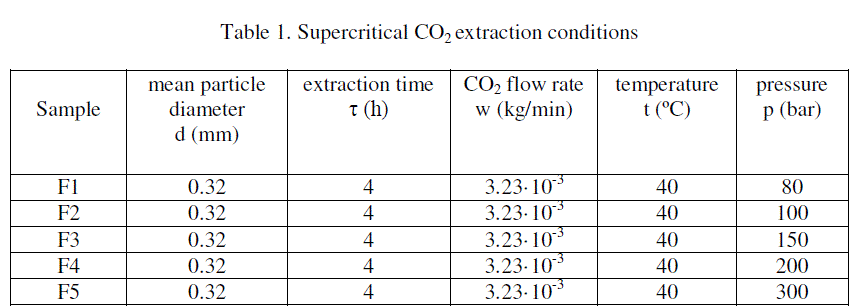 |
| In order to prevent thermal decomposition of some volatile oil compounds, the temperature of supercritical fluid extraction of 40°C was selected. The pressure range of 80 – 300 bar (a pronounced change in the density and dielectric constant, i.e. solubility power of carbon dioxide) for SFE of Salvia officinalis L. was investigated. The selections of the pressures ranges are based on the fact that a great change in the density and dielectric constant of CO2 occurs between pressure 80 and 150 bar. Investigations of extraction kinetics of sage in the function of pressure are obtained results which were shown in the Fig. 1. |
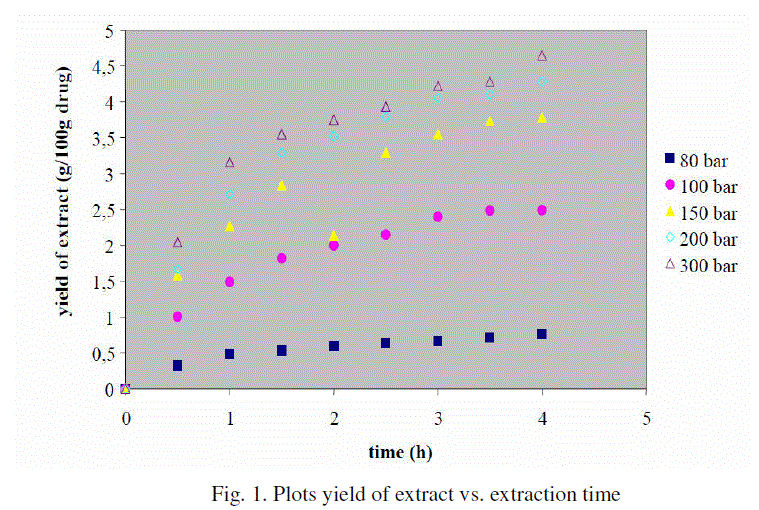 |
| Results showed that increasing pressure from 80 to 300 bar enhanced the extraction yield, which was due to the increased SCCO2 density at higher pressures. Also extract obtained at pressure 80 bar has the highest content of essential oil (58.79%), while the contents in other extracts were from 29.90 to 47.87%. |
| CO2 extracts and essential oils obtained from CO2 extracts were detailed identification and quantification using GC/MS and GC/FID analyses. The results of qualitative and quantitative analyses were given in table 3 and table 4. |
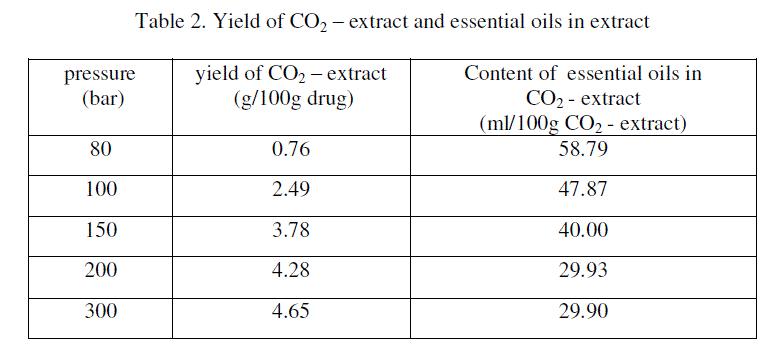 |
| It can be seen from table γ that the extracts obtained at pressure 150 and β00 bar consists ïÿý – thujone while other extracts does not consists it. Dominant components are phyllocladene, – elemene, isoborneole, selina – 3,7 (11) diene, camphor, 1,11 – epoxyhumulene. In extract component contents varying in the function of pressure. Content of phyllocladene in extract obtained at presurep = 80 bar is 10.42%, while in other extracts is from 21.99 to 30.64%. At the pressure p = 80bar content of camphor is least (1.43%), at other pressures it is from 11.37 to 15.24%. Extract obtained at pressure p = 80bar, contents – elemene 24.98%, while in other extracts content is from 7.02 to 9.73%. Also, we have seen that the extract obtained at pressure p = 80bar contents a lot of 1,11 – epoxyhumulene (8.99%), in other extracts (4.56 – 5.87%). Content of selina 3,7 (11) diene is approximately equal in all obtained extracts (11.25 - 13.83%). |
| Qualitative contents of essential oils obtained from CO2 extracts at pressure 80, 100, 150 and 200 bar) is same, while essential oil obtained at pressure γ00 bar is different. This essential oil has not ïÿý – pinen. All essential oils have similar quantitative contents in regard dominated components. Dominated component are: α – thujone, camphor, isoborneole, – elemene. From results shown in table 4, we can conclude that investigated essential oils content α – thujone (15.63 – 27.38%) in high percentage. Also, essential oil from extract obtained at pressure 300 bar there is phyllocladene in high percentage (23.37%). In other essential oils there is phyllocladene from 4.19 to 6.90%. In essential oil from extract obtained at pressure 80 bar content of – elemene is the highest (15.52%), and in other essential oils are (7.46 – 9.86%). Camphor content is similar in all essential oils (16.03 – 23.45%). In continue of investigation, the extraction of kinetics in the function of pressure (80, 100 and 200 bar) was performed. Now every point of kinetic curve was obtained with new sample of drug in extractor. Results of investigation of kinetics extraction are shown on the Fig 2. |
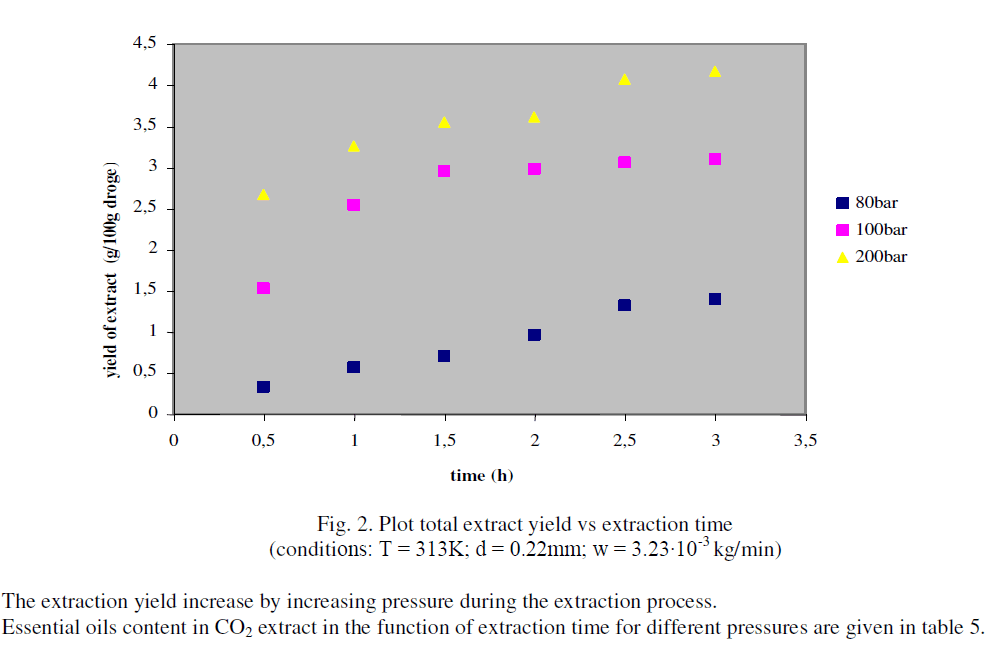 |
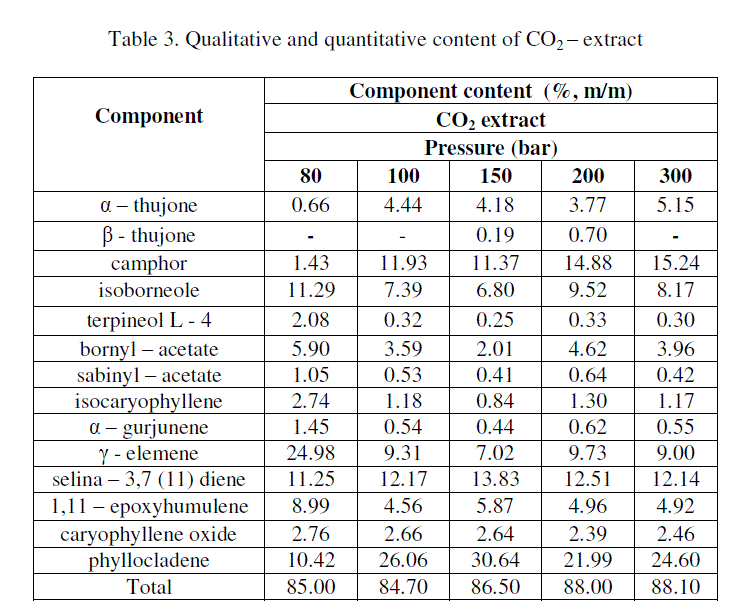 |
| Content of essential oil in residual drug which firstly extracted by carbon dioxide at pressure p = 80 bar is from 0.2 to 0.66% and it is significant amount in regard to drug extracted on pressure p = 100bar (0.04%) and pressure p = 200 bar (0.02%). |
| From results (table 5 and 6) we can see that extract yield of sage is increasing and essential oil content is decreasing at defined pressure during the extraction of sage. The essential oil content is decreasing with the time because the extract yield is increasing with the time. |
CONCLUSION |
| The solubility of investigated sage is equal to their yield. So it could be concluded that sage solubility increase by increasing of carbon dioxide pressure, i.e. density or solubility power of extragent. According to the results of this investigation, SFE offered more choices (pressures level) for the extraction of different components. |
References |
|